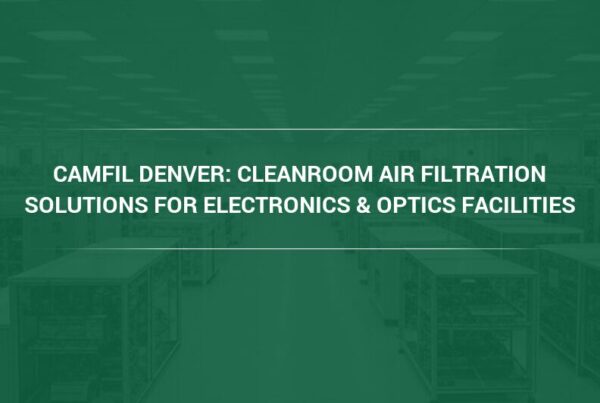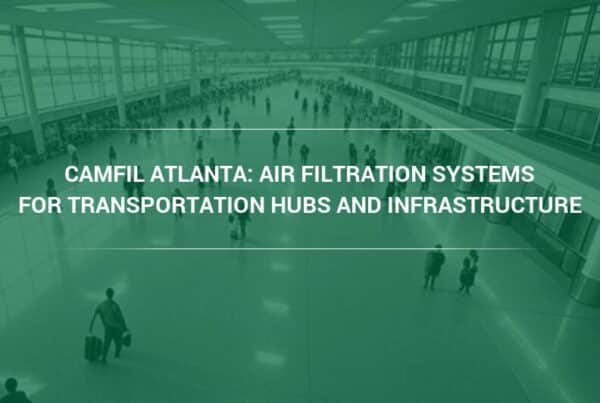Data centers and server rooms are facing increased demands due to the continuous influx of data and the rising demand for artificial intelligence, real-time analytics, and other computationally intensive tasks. As a result, they are operating at higher capacities than ever before.
The density and energy consumption within these spaces is continuously increasing, and the reliance on technology and data, along with the cost of downtime, has reached unprecedented levels. Because of the sensitivity of the equipment used in data centers and server rooms, poor indoor air quality can affect hardware performance and even lead to server failure, forcing significant downtime and financial loss for repairs and replacement.
According to the Uptime Institute’s Outage Analysis report of 2022, 60 percent of digital infrastructure outages now incur costs of at least $100,000, compared to 39 percent in 2019. A significant number of organizations surveyed (one in five) experienced “serious” or “severe” outages in the past three years, resulting in substantial financial losses, damage to reputation, violations of compliance regulations, and even instances of loss of life.
Furthermore, the impact of poor indoor air quality on human well-being, daily productivity, and physical health in these spaces should not be overlooked. In addition to its effects on employees, inadequate indoor air quality, whether caused by dust and other particulate matter or harmful gaseous chemicals, can also hamper technology performance and lead to equipment failures and outages. These disruptions result in expensive downtime, unplanned repairs and replacements, dissatisfied customers, and potential breaches of compliance regulations.
In this article, Camfil air quality experts take a look at why indoor air quality poses a problem in these environments, explore possible solutions to enhance indoor air quality in data centers and server rooms, and highlight the benefits that organizations can gain by investing in cleaner air.
Common Air Pollutants in Data Centers and Obstacles to Better Air Quality
In prominent media and public policy discussions, outdoor air quality usually takes center stage. However, indoor air quality can be as much as fifty times more polluted than the outdoor air in the corresponding area because pollutants can become highly concentrated in stagnant or recirculated air.
Data centers and server rooms inevitably contain contaminants. Merely opening a door can introduce these impurities into the space. Moreover, outdoor air pollution from sources such as auto exhaust, manufacturing, and industrial processing, and natural particulates like pollen, dander, and dust can infiltrate data centers and server rooms through ventilation systems.
Gaseous air pollutants like sulfur dioxide, hydrogen sulfide, and chlorine salt can corrode and damage not only servers, drives, and computer processors, they can also harm power and cooling systems that keep equipment running and prevent overheating.
When servers overheat, the air can become warm and humid, leading to moisture that corrodes its hardware. Essentially, servers themselves can be the source of gaseous contaminants that cause significant damage. Furthermore, dust and particulate matter can obstruct airflow and hinder the optimal functioning of moving parts.
Ventilation systems in data centers and server rooms circulate and replace the air 30 to 50 times per hour, compared to the average commercial office’s rate of only two to six times per hour. Simultaneously, these systems must effectively filter out harmful contaminants while maintaining acceptable air quality and helping employers meet occupational safety and health standards for workers.
In summary, maintaining the highest level of indoor air quality is a complex task, but it should be a top priority to ensure that your organization operates at an optimal level.
Strategies for Improving Indoor Air Quality in Data Centers and Server Rooms
Data center equipment can be protected through the goal of minimizing contaminants and maintaining clean air. Continue reading to discover tips from air quality experts for improved data center air quality.
Temperature and Humidity
Today’s high-density environments demand reliable maintenance and monitoring of temperature and humidity levels. The American Society of Heating, Refrigerating and Air-Conditioning Engineers (ASHRAE) has developed guidelines for these metrics.
For A1 to A4 equipment, ASHRAE recommends maintaining a dew point temperature range of -9℃ to 15℃ (16℉ to 59℉) and a relative humidity of 50 to 70 percent. It is also important for organizations to adhere to the recommendations provided by hardware manufacturers and to install sensors that can generate alerts when these levels deviate from the acceptable range.
Ventilation and Air Circulation
Proper ventilation and air circulation are needed to improve indoor air quality, cool equipment, prevent the buildup of moisture, and keep equipment running at maximum efficiency and performance.
The warm air created by the heat produced in data center and server room components needs to be continuously replaced with cool air. Additionally, effective airflow management should consider factors such as flooring, spacing between racks and rows, room temperature, HVAC ducts, and other relevant considerations.
Air Filtration and Air Purification Systems
A robust air filtration system will maintain clean air within data centers or server rooms. This system not only purifies the air but also pressurizes it to prevent the entry of external air pollutants and particles into the facility. When selecting an air filtration system, prioritize those with real-time monitoring capabilities to ensure optimal efficiency of the filtration devices.
Air purifiers with highly efficient HEPA and molecular filters improve indoor air quality by eliminating dust particles, air pollutants, VOCs, odors, and other harmful gases. They will even remove diesel fumes that may enter your facility from the outdoor environment. Choose particulate air filters with five-star ratings through the Energy Cost Index program. This indicates the filter is the most energy-efficient, longest-lasting filter available. For molecular filters, make sure they are validated under ISO Standard 10121.
Low-Emission Equipment and Materials
By utilizing low-emission equipment and materials, such as air filters manufactured with fewer chemicals and eco-friendly substances, data centers and server rooms can achieve multiple benefits. These measures not only contribute to improved indoor air quality but also lead to reduced energy consumption and carbon dioxide emissions.
Best Practices for Housekeeping and Cleaning
The unfortunate reality is that many commercial facilities are a primary source of their own air pollutants and contribute to their own poor indoor air quality. Ironically, housekeeping and cleaning procedures are among the biggest culprits because they tend to spread chemicals and particulates instead of containing and removing them.
The Environmental Protection Agency (EPA) recommends minimizing the use of chemical cleaners indoors. Use mild soap and water and look for the EPA’s Safer Choice label when choosing cleaning products. Safer Choice is part of the EPA’s pollution prevention (P2) initiative, which focuses on reducing, eliminating, or preventing pollution at its source.
Good Business, Good Health: The Benefits of Clean Air
When you learn how to improve indoor air quality in data centers and server rooms, you improve the health of your equipment and your business. Air pollutants can damage technology and cause equipment to fail. At the very least, the pollutants affect performance and efficiency.
Cleaner air reduces the risk of costly downtime and repairs and increases equipment lifespan, allowing you to maximize the return on your infrastructure investments and avoid early replacement of equipment.
Better indoor air quality can also make a meaningful difference in employee health. A cleaner, safer work environment often translates to fewer sick days, more energy, improved morale, higher employee retention rates, and higher productivity.
Finally, improving air quality in your data centers and server rooms contributes to substantial cost savings. By reducing energy consumption, reducing repair and maintenance costs, extending the life of equipment, and reducing the risk of downtime, investments in air quality can have a six-figure impact on your bottom line.
How is the Air Quality in Your Data Center and Server Rooms?
The importance of indoor air quality in these critical areas cannot be emphasized enough. While organizations often prioritize data security and physical security, they don’t always realize that indoor air quality can be equally important to ensure smooth daily operations, prevent downtime, and safeguard valuable business assets, including infrastructure and human capital.
To improve indoor air quality in data centers and server rooms:
- Maintain temperature and humidity levels according to ASHRAE and manufacturer recommendations.
- Ensure proper ventilation and air circulation to continuously replace warm air with cool, clean air.
- Install or upgrade air filtration and air purification systems with high-quality particulate and molecular filters to minimize the presence of air pollutants.
- Look for low-emission equipment made from eco-friendly materials to reduce environmental impact and energy consumption.
- Implement housekeeping and cleaning best practices that prevent the spread of particulates and chemicals.
Camfil manufactures premium clean air solutions and offers a comprehensive approach to improving indoor air quality. We can help you evaluate the current air quality in your data centers and server rooms, recommend equipment and technology based on your specific goals and requirements, predict total cost of ownership using our Life Cycle Cost software, and deploy the appropriate solutions.
Camfil Air Filter Solutions for Data Centers
By incorporating Camfil’s five-star air filters into your existing air ventilation systems, you can achieve remarkable energy savings of up to 40% by optimizing airflow. These filters have been awarded a five-star rating through the Energy Cost Index (ECI) program. The ECI program employs a five-star scale to assess the lifetime cost of a filter. A five-star rating signifies that the filter is not only the most energy-efficient option but also offers the longest filter life.
To ensure superior filtration efficiency and protect sensitive electronic equipment in data centers, it is recommended to begin with high-quality prefilters such as the Camfil 30/30 Dual 9 pleated panel air filters, which effectively control larger airborne contaminants. Pairing the 30/30 Dual 9 with the Durafil ES filter enables the air handling system to target submicron particles. The Durafil ES filter is available in MERV ratings ranging from 11 to 16, providing the capability to filter out particles as small as 0.3 microns in size.
Camfil’s Hi-Flo ES filter is particularly well suited for data center applications, offering an optimal blend of filtration efficiency and energy savings without requiring a prefilter. This filter effectively filters both large particles and submicron-sized particles from the air, all while consuming less energy compared to a conventional prefilter/filter setup.
Camfil believes the best clean air solutions for people are also the best solutions for your technology infrastructure and the planet. Please contact us to discuss your organization’s concerns and challenges so we can help you implement strategies that improve indoor air quality in your data centers and server rooms.
Camfil Clean Air Solutions
For over 50 years, Camfil has been at the forefront of promoting cleaner air for everyone. As a leading manufacturer of top-quality clean air solutions, we specialize in delivering commercial and industrial systems for air filtration and air pollution control. Our solutions not only enhance productivity for workers and equipment but also contribute to energy efficiency while prioritizing human health and the environment.
We firmly believe that what is best for our customers is also best for our planet. That’s why we integrate sustainability considerations into every aspect of our operations, from design and production to delivery and throughout the product life cycle. By embracing innovative problem-solving, cutting-edge design, meticulous process control, and a steadfast commitment to customer satisfaction, we strive to conserve resources, reduce waste, and discover superior ways to make breathing easier for all.
The Camfil Group is headquartered in Stockholm, Sweden, and has 30 manufacturing sites, six R&D centers, local sales offices in 35+ countries, and about 5,600 employees and growing. We proudly serve and support customers in a wide variety of industries and in communities across the world. To discover how Camfil USA can help you to protect people, processes, and the environment, visit us at www.camfil.us/.



